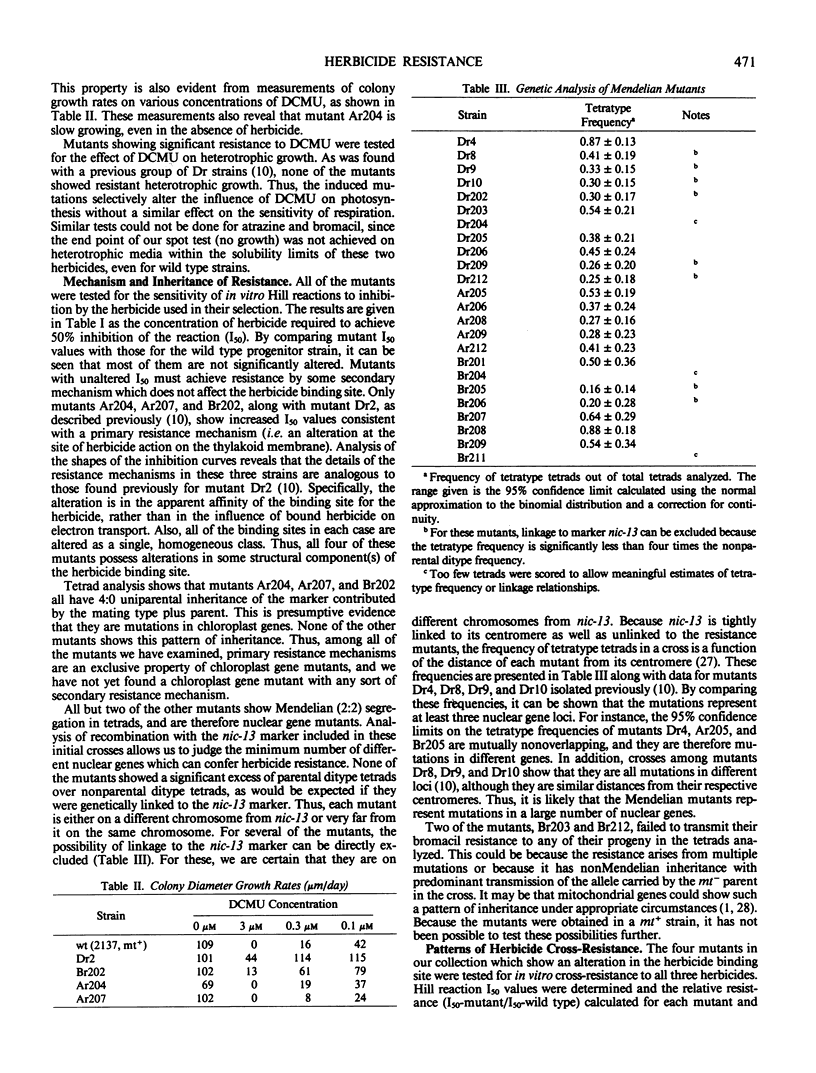Abstract
A series of Chlamydomonas reinhardii mutants were selected for resistance to the herbicides atrazine, bromacil, and diuron. Four of these have reduced herbicide binding to the thylakoid membranes and show the non-Mendelian inheritance pattern characteristic of chloroplast genes. These mutants show a variety of selective alterations in binding of the three herbicides. These changes account for the observed patterns of in vivo cross-resistance. Analyses of chloroplast gene recombination indicate that these four mutations are in the same gene. Overall, the results suggest that this gene codes for a protein component of the herbicide binding site. One of the mutants has slow phototrophic growth and altered electron transport as has been observed in atrazine-resistant higher plant varieties, but the others are normal in these respects. The slow growth characteristic of this mutant seems to be the consequence of the same mutation which confers herbicide resistance.
The mutants isolated also include a large number which achieve resistance by some secondary mechanism. These are all nuclear gene mutations, and represent numerous loci. They also show a variety of patterns of cross-resistance, but the mechanisms behind them have not yet been investigated.
Full text
PDF





Images in this article
Selected References
These references are in PubMed. This may not be the complete list of references from this article.
- Arntzen C. J., Ditto C. L., Brewer P. E. Chloroplast membrane alterations in triazine-resistant Amaranthus retroflexus biotypes. Proc Natl Acad Sci U S A. 1979 Jan;76(1):278–282. doi: 10.1073/pnas.76.1.278. [DOI] [PMC free article] [PubMed] [Google Scholar]
- Bowes J., Crofts A. R., Arntzen C. J. Redox Reactions on the reducing side of photosystem II in chloroplasts with altered herbicide binding properties. Arch Biochem Biophys. 1980 Apr 1;200(2):303–308. doi: 10.1016/0003-9861(80)90359-8. [DOI] [PubMed] [Google Scholar]
- Darr S., Souza Machado V., Arntzen C. J. Uniparental inheritance of a chloroplast photosystem II polypeptide controlling herbicide binding. Biochim Biophys Acta. 1981 Jan 14;634(1):219–228. doi: 10.1016/0005-2728(81)90140-7. [DOI] [PubMed] [Google Scholar]
- EBERSOLD W. T., LEVINE R. P. A genetic analysis of linkage group I of Chlamydomonas reinhardi. Z Vererbungsl. 1959;90(1):74–82. doi: 10.1007/BF00888575. [DOI] [PubMed] [Google Scholar]
- Galloway R. E., Mets L. Non-Mendelian Inheritance of 3-(3,4-Dichlorophenyl)-1,1-dimethylurea-Resistant Thylakoid Membrane Properties in Chlamydomonas. Plant Physiol. 1982 Dec;70(6):1673–1677. doi: 10.1104/pp.70.6.1673. [DOI] [PMC free article] [PubMed] [Google Scholar]
- Holt J. S., Stemler A. J., Radosevich S. R. Differential Light Responses of Photosynthesis by Triazine-resistant and Triazine-susceptible Senecio vulgaris Biotypes. Plant Physiol. 1981 Apr;67(4):744–748. doi: 10.1104/pp.67.4.744. [DOI] [PMC free article] [PubMed] [Google Scholar]
- Mets L. J., Geist L. J. Linkage of a Known Chloroplast Gene Mutation to the Uniparental Genome of CHLAMYDOMONAS REINHARDII. Genetics. 1983 Nov;105(3):559–579. doi: 10.1093/genetics/105.3.559. [DOI] [PMC free article] [PubMed] [Google Scholar]
- Pfister K., Radosevich S. R., Arntzen C. J. Modification of Herbicide Binding to Photosystem II in Two Biotypes of Senecio vulgaris L. Plant Physiol. 1979 Dec;64(6):995–999. doi: 10.1104/pp.64.6.995. [DOI] [PMC free article] [PubMed] [Google Scholar]
- Pillai P., John J. B. Lipid composition of chloroplast membranes from weed biotypes differentially sensitive to triazine herbicides. Plant Physiol. 1981 Sep;68(3):585–587. doi: 10.1104/pp.68.3.585. [DOI] [PMC free article] [PubMed] [Google Scholar]
- Van Winkle-Swift K. P., Birky C. W., Jr The non-reciprocality of organelle gene recombination in Chlamydomonas reinhardtii and Saccharomyces cerevisiae: some new observations and a restatement of some old problems. Mol Gen Genet. 1978 Oct 30;166(2):193–209. doi: 10.1007/BF00285922. [DOI] [PubMed] [Google Scholar]
- WHITEHOUSE H. L. K. Mapping chromosome centromeres by the analysis of unordered tetrads. Nature. 1950 Jun 3;165(4205):893–893. doi: 10.1038/165893a0. [DOI] [PubMed] [Google Scholar]
- Wiseman A., Gillham N. W., Boynton J. E. The mitochondrial genome of Chlamydomonas. II. Genetic analysis of non-mendelian obligate photautotrophic mutants. Mol Gen Genet. 1977 Jan 18;150(2):109–118. doi: 10.1007/BF00695390. [DOI] [PubMed] [Google Scholar]



